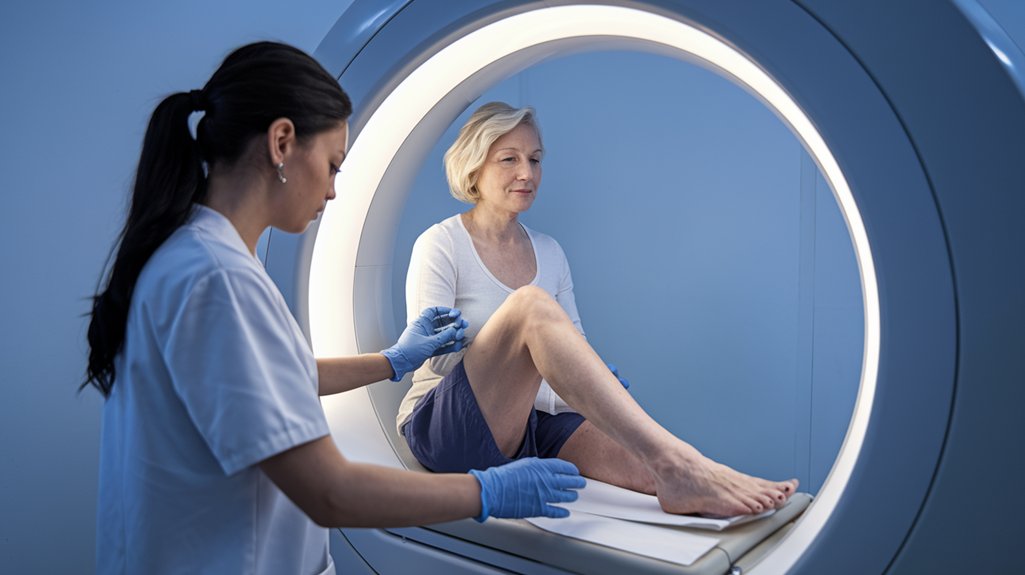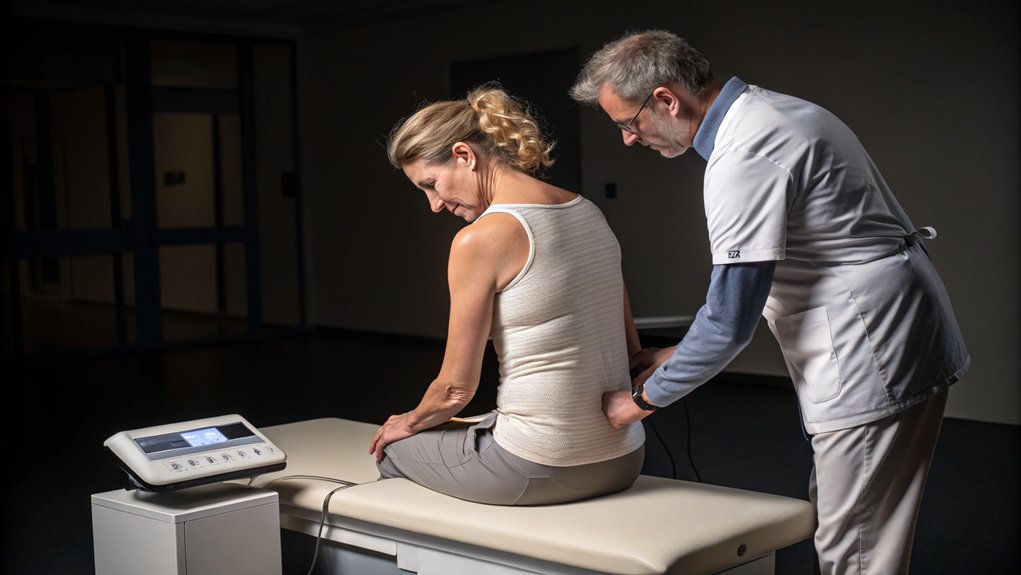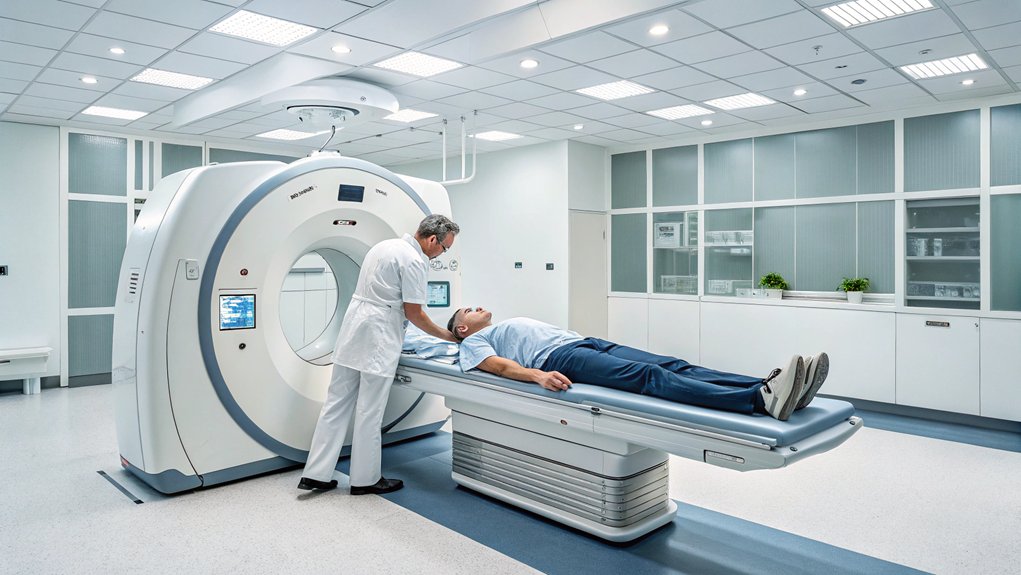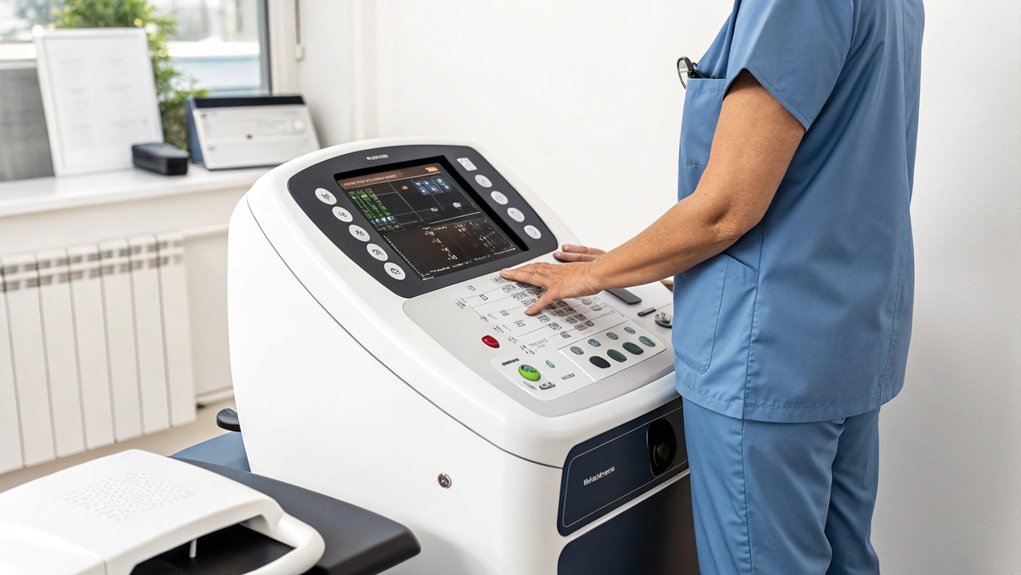
An annual bone density test is essential for maintaining strong, healthy bones. As osteoporosis can develop silently, it’s important to uncover early signs before fractures occur. If you’re over 50 or have risk factors like a family history or prior fractures, you should prioritize testing. This proactive step empowers you to manage your bone health effectively. If you’re curious about the different test types and what to expect, keep exploring further.
Main Points
- Annual bone density tests are crucial for early detection of osteoporosis, reducing fracture risk and enabling proactive management of bone health.
- Regular testing, especially for individuals over 50, allows for monitoring changes in bone density over time and adjusting treatment as needed.
- Accurate measurement using DXA scans provides reliable T-scores, aiding in the evaluation of bone health and potential fracture risk.
- Insurance often covers these tests, making them accessible for those at risk, especially women over 65 and men over 70.
- Maintaining strong bones through regular screenings empowers individuals to make informed lifestyle choices and reduce the likelihood of future fractures.
Who Should Have a Bone Density Test?

Are you aware of who should consider a bone density test? If you’re a woman aged 65 or older or a man aged 70 and up, these tests are vital for evaluating your osteoporosis risk. Additionally, if you’re 50 or older and have experienced a fracture, it’s essential to assess your bone health. Don’t overlook your health history—if you’re a younger woman facing specific risk factors, like a family history of osteoporosis or prolonged medication use, chat with your healthcare provider about testing. Regular bone density tests can help identify individuals at higher risk for fractures, enabling early interventions and prevention strategies. With insurance often covering these tests, it’s an important step toward proactive healthcare. Recognizing the importance of bone health is a key part of maintaining a strong, vibrant life, so take this opportunity to safeguard your future.
Types of Bone Density Tests
Understanding the types of bone density tests can really empower you in managing your bone health. Central methods like DXA and QCT offer detailed assessments, while peripheral options like pDXA and QUS provide a more accessible snapshot. Each method has its strengths and limitations, and recognizing these differences can help you make informed decisions about your care.
Central Testing Methods
When it comes to evaluating bone health, employing central testing methods like DXA and QCT can make all the difference. DXA, the most reliable way to measure bone density, focuses on critical areas such as your hip and spine while exposing you to minimal radiation—similar to a cross-country flight. Conversely, QCT primarily assesses bone mineral density in the spine but carries higher radiation risks, making it less common for routine screenings. Regular use of these central testing methods supports personalized treatment plans and enables early detection of osteoporosis risks. Understanding your results empowers you to take proactive steps toward maintaining strong, healthy bones and ultimately improving your quality of life. Prioritize these assessments for a holistic approach to your bone health.
Peripheral Testing Methods
While central testing methods are often prioritized for evaluating bone density, peripheral testing methods play a significant role, especially in initial screenings. Techniques like peripheral quantitative computed tomography (pQCT) and peripheral dual-energy X-ray absorptiometry (pDXA) target specific areas, such as the wrist or heel, offering quick, portable options for bone density testing. Quantitative ultrasound (QUS) is another radiation-free method that assesses heel density efficiently. These screening tests can help identify individuals at risk for low bone density, but they shouldn’t replace thorough DXA scans. Remember, while these methods are valuable, they fall short in diagnosing conditions like osteoporosis, emphasizing the need for follow-up with central testing for a complete understanding of your bone health.
Diagnostic Accuracy Comparison
Many individuals seeking to monitor their bone health may feel overwhelmed by the variety of tests available. The gold standard for bone density measurement is the DXA (dual-energy X-ray absorptiometry) test, known for its accuracy at evaluating bone density in the hip and spine, providing a reliable T-score to disclose your status, whether normal, osteopenia, or osteoporosis. Peripheral methods like pDXA and QUS can be convenient but often lead to less reliable results. While QCT (quantitative computed tomography) provides high-resolution images of bone density, its cost and radiation levels make it less common. Regularly opting for DXA guarantees you have the most accurate insights on your bone health, especially during osteoporosis treatment, allowing for careful monitoring of your progress.
Understanding Insurance Coverage for Bone Density Tests
Managing insurance coverage for bone density tests can feel overwhelming, but understanding the criteria is essential for your health. Medicare often provides benefits for those over 65, yet each insurance plan has its own specifics that you’ll need to review. By consulting with your healthcare provider and your insurance plan, you can clarify your eligibility and potential costs, ensuring you get the care you need.
Coverage Criteria Overview
Understanding the insurance coverage for bone density tests can feel overwhelming, especially when considering the various factors that might apply to your unique situation. Many health insurance plans, including Medicare, offer coverage based on specific risk factors like history of fractures and menopause status. If you’re over 65 and at risk for osteoporosis, Medicare allows testing every two years. Conditions such as fractures after age 50 often qualify you for insurance coverage too. To navigate this, it’s critical to consult your healthcare provider, who can clarify eligibility and guidelines around bone density tests. This proactive approach helps you understand your bone density test results and any potential out-of-pocket costs, ensuring you make informed decisions for your health.
Medicare Benefits Explained
Medicare provides valuable benefits when it comes to bone density tests, especially for those over 65 at risk for osteoporosis. If you have a personal history of fractures, are post-menopausal, or take medications that may contribute to bone thinning, you may qualify for coverage. Medicare allows for these vital tests every two years, using DXA scans to accurately diagnose osteoporosis and monitor treatment. To guarantee your test is covered, it’s important to consult your healthcare provider about its medical necessity. Remember, most private health insurance plans also cover bone density testing, reflecting similar criteria. Understanding these benefits empowers you to take charge of your bone health, assuring you receive the support you need.
Insurance Plan Variability
While it can feel overwhelming to unravel the details of insurance coverage for bone density tests, knowing the specifics can make a significant difference in your care. Insurance plan variability can impact your access to these essential assessments, especially if you’re aged 65 and older or have specific risk factors like a history of fractures or menopause. Medicare typically covers bone density tests every two years, helping you monitor your bone health consistently. However, some insurance plans might require prior authorization or impose limits on test frequency. Understanding your policy’s coverage can also help guarantee that adjustments to osteoporosis medications are made when necessary. Stay proactive in discussing your needs with your provider and insurer for ideal bone health.
Preparing for Your Bone Density Test
Preparing for your bone density test is an essential step in ensuring accurate results and a smooth experience. To promote your health, it’s advisable to avoid taking calcium supplements for at least 24 hours prior; this can greatly influence your test outcomes. If you’ve recently had a barium or contrast exam, inform your healthcare provider, as this may also affect results.
When you arrive, wear loose, comfortable clothing, as some facilities may require you to change into an examination gown. While the preparation is minimal, bringing any necessary prescriptions or referrals will help things run more smoothly.
The Test Procedure: What to Expect

A bone density test usually takes between 10 to 30 minutes, allowing you to quickly understand more about your bone health. During the test procedure, you’ll lie on a special X-ray table while a scanning arm passes over your body. The most common method, the DXA scan, uses low levels of X-rays to measure bone density in your spine, hip, and sometimes your forearm. Minimal preparation is needed, but be sure to avoid calcium supplements for at least 24 hours prior to your appointment. Also, inform your healthcare provider if you’ve had any recent barium or contrast exams. Remember, testing facilities should have certified staff, so it’s helpful to bring a prescription or referral to your visit. Your results will be reported as T-scores, giving valuable insights into your bone health, helping to identify potential concerns like osteopenia or osteoporosis.
Interpreting Your Bone Density Test Results
How can you make sense of your bone density test results? Understanding your T-score is essential for evaluating your bone health and fracture risk. Here’s a quick breakdown:
- A T-score of -1.0 or higher indicates normal bone density.
- Scores between -1.0 and -2.5 suggest osteopenia, meaning your bone density is below normal.
- A T-score of -2.5 or lower confirms osteoporosis, greatly increasing fracture risk.
- Z-scores offer insights compared to age-matched peers, identifying potential health-related causes.
- Regular monitoring is important; retesting every 1-2 years helps track changes.
Recognizing these numbers can empower you to take actionable steps. If your results hint at deteriorating bone density or osteoporosis, discussing lifestyle changes or treatments with your healthcare provider is key. You’re not alone on this journey towards stronger, healthier bones.
Related Health Conditions and Osteoporosis

Understanding your bone density test results is just one part of the bigger picture of bone health. Conditions like anorexia nervosa and hyperparathyroidism can lead to significant bone density loss, making osteoporosis a real concern. If you have a family history of osteoporosis, your risk of breaking bones increases, especially with fragility fractures—those that occur from minimal trauma, like a fall from standing height. This is a powerful indicator that your bones may be weakening.
Moreover, factors like long-term corticosteroid use, excessive alcohol consumption, and a sedentary lifestyle can further exacerbate the decline in bone health. On the other hand, engaging in regular physical activity can help maintain and even improve your bone density. Prioritizing movement not only boosts your physical health but also enhances your overall well-being as you work to prevent osteoporosis and sustain your bone strength for years to come.
Importance of Regular Bone Density Testing for Maintenance of Bone Health
While you may not feel any immediate effects, being proactive about your bone health through regular density testing is essential. Regular bone density tests, like the DXA scan, help detect osteoporosis early, greatly reducing your risk of fractures. Here’s why routine testing matters:
- It accurately measures your bone mineral content.
- Provides T-scores to assess bone density levels.
- Guides treatment plans and preventive strategies.
- Enables timely interventions for those on osteoporosis medications.
- Access is often covered by insurance, including Medicare.
With osteoporosis being a silent condition, you could be unaware of your declining bone health. Early detection allows you to make informed choices that can safeguard your strength and stability. By committing to regular testing, you empower yourself to manage your bone health effectively and minimize the risk of potentially debilitating fractures as you age.
Frequently Asked Questions
Is a Bone Density Test Really Necessary?
You’ll find a bone density test essential for understanding your osteoporosis risk. Regular testing emphasizes the importance of preventative measures, guiding your health decisions, and helps in interpreting results effectively for better bone health management.
What Is a Bad Number for a Bone Density Test?
A T-score below -1.0 indicates bad bone density, signaling potential osteopenia. Understanding results helps you assess fracture risk. Taking preventative measures can markedly improve your bone health and reduce future complications. Stay proactive for better outcomes!
What Are the Requirements for a Bone Density Test?
To qualify for a bone density test, consider your risk factors, like age and history of fractures. Proper test preparation helps guarantee accuracy, and understanding result interpretation guides necessary follow-up care for your bone health.
Can a Bone Density Test Detect Other Problems?
Yes, a bone density test can reveal more than osteoporosis assessment. Through results interpretation, it can indicate fracture risk and prompt additional imaging for potential issues, enhancing diagnostic accuracy and ensuring a thorough understanding of your bone health.
Conclusion
To sum up, getting an annual bone density test is essential for maintaining your bone health. It helps you catch any issues early, allowing for effective management and prevention of conditions like osteoporosis. By understanding your results and discussing them with your healthcare provider, you empower yourself to make informed choices for a stronger, healthier future. Remember, prioritizing your bone health today sets the foundation for a vibrant life tomorrow. Don’t wait—take charge of your bones!
